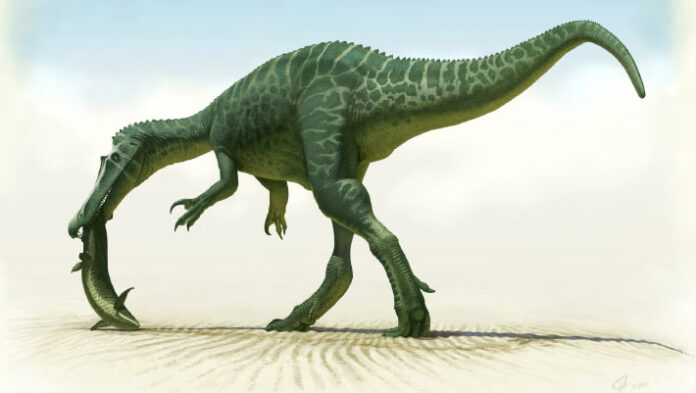A new genus and species of spinosaurid dinosaur being named Riojavenatrix lacustris has been discovered by University of the Basque Country paleontologist Erik Isasmendi and his colleagues.
An artist’s reconstruction of the spinosaurid dinosaur Baryonyx. Image credit: Andrey Atuchin / CC BY 4.0 Deed.
Spinosaurids (Spinosauridae) are a family of large theropod dinosaurs known from the mid-Cretaceous period.
These dinosaurs are characterized by long skulls with conical teeth that are convergent with those of crocodylians and robust limbs with a massive thumb claw.
They grew to enormous size, and at least one species, Spinosaurus aegyptiacus, grew as large or larger than Tyrannosaurus rex.
In many spinosaurid species, the neural spines of their vertebrae were significantly elongated and formed a sail on the dinosaur’s back.
Spinosaurids are thought to be piscivorous (fish-eating) based on their piercing teeth and the characteristics of their skull and jaws.
Their fossils have been recovered worldwide, including Africa, Europe, South America and Asia.
The newly-identified spinosaurid lived in what is now Spain during the Early Cretaceous epoch, around 120 million years ago.
Scientifically named Riojavenatrix lacustris, the species was up to 7-8 m (23-26 feet) long and weighed 1.5 tons.
“Riojavenatrix lacustris is one of the latest Iberian and European spinosaurid species,” Isasmendi and co-authors said.
“It retains a triangular pubic boot, like the megalosaurids, and a medial condyle of the femur that shows a transitional stage between the anteroposteriorly oriented long axis of non-spinosaurid theropods and the posteromedially oriented long axis of Spinosauridae.”
The fossilized bones from Riojavenatrix lacustris were collected from the Enciso Group of the Cameros Basin in La Rioja, Spain.
“Along with Riojavenatrix lacustris, five spinosaurids have now been described from the Lower Cretaceous of the Iberian Peninsula,” the paleontologists said.
“The other Iberian spinosaurids are Camarillasaurus from Aragon, Vallibonavenatrix and Protathlitis from Valencia, and Iberospinus from Portugal.”
“Fossil remains testify that the Iberian Peninsula was home to a large, diverse assemblage of these carnivorous dinosaurs.”
“The numerous discoveries within this iconic group raise multiple new questions about the ecology of these animals,” said Dr. Elena Cuesta, a paleontologist at the Museum of Palaeontology Egidio Feruglio and Ludwig Maximilian University.
“How did these species coexist with each other?”
“Questions like this are prompting us to consider again future, more detailed studies into spinosaurids, which are sure to yield significant results.”
The findings were publsihed in the journal Zoological Journal of the Linnean Society.
_____
Erik Isasmendi et al. Increasing the theropod record of Europe: a new basal spinosaurid from the Enciso Group of the Cameros Basin (La Rioja, Spain). Evolutionary implications and palaeobiodiversity. Zoological Journal of the Linnean Society, published online February 19, 2024; doi: 10.1093/zoolinnean/zlad193



